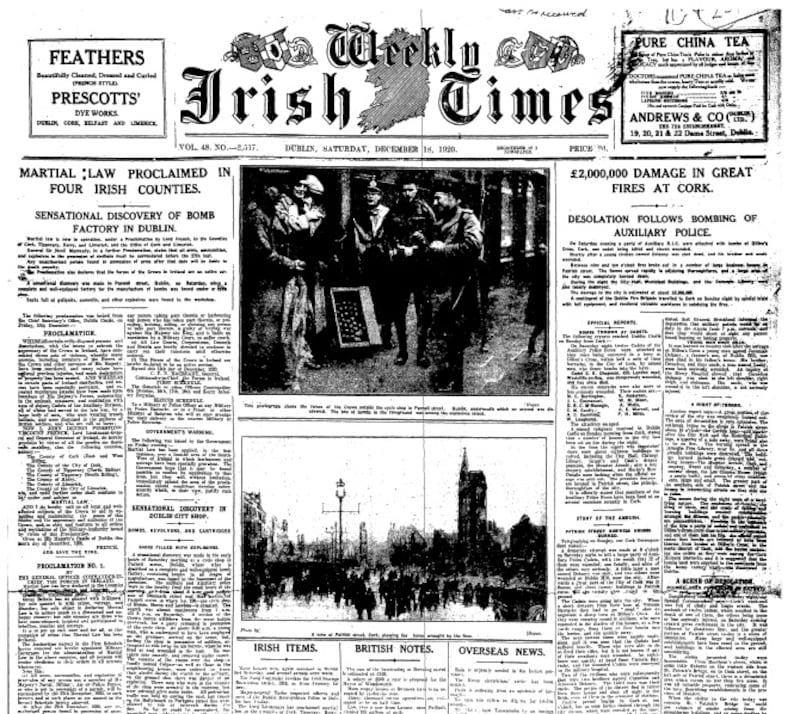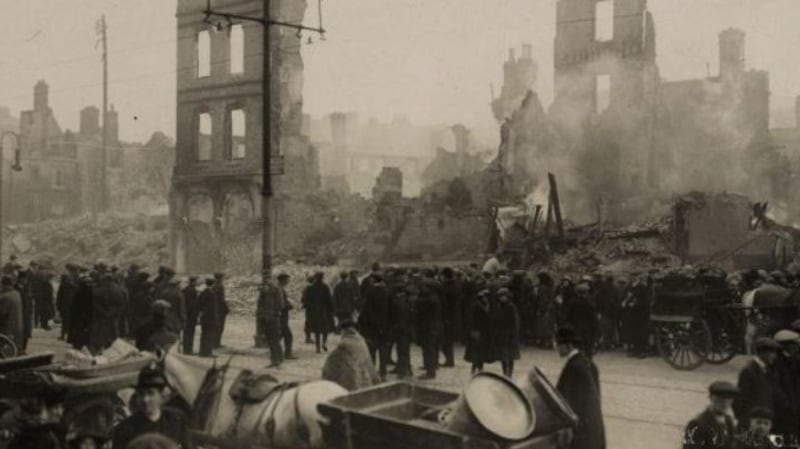When the fires stopped, the people of Cork were left sifting through debris, with many left homeless, thousands jobless and all counting the cost of blazes started by British forces.
That was the state of affairs described by the correspondent for The Irish Times in the days following the Burning of Cork on the night of December 11th-12th 1920.
That night, 100 years ago, British forces looted and burned buildings, leaving large portions of Cork city centre – including much of Patrick Street – destroyed. The mayhem followed an IRA ambush on a party of Auxilaries at Dillon’s Cross earlier in the day, which left one dead and others injured.
Something very special is beginning at City Hall as we mark the devastation that beset this city on this night 100 years ago #BurningofCork #Cork1920 pic.twitter.com/rVA8Zcl8tQ
— Cork City Council (@corkcitycouncil) December 11, 2020
However, in the immediate aftermath of the fires, there was no official blame placed on any British forces personnel. In some quarters, the opposite was the case.
Hamar Greenwood, Chief Secretary of Ireland, laid the blame far from the feet of Crown forces when he spoke in parliament: “There is some evidence that they were started by incendiary bombs,” he said, according to an Irish Times report on the 14th. “There are incendiary bombs in the possession of the Sinn Féiners, and we are seizing them every week.” The fires, he said, were not connected to the Dillon’s Cross ambush.
Greenwood said the work of the fire brigade was helped by police and soldiers, who managed the crowds – denying allegations that firefighters’ efforts were sabotaged by British forces: “There is no evidence of hoses being cut or of forces of the Crown being responsible for these outrages at all.” His take on events – “he did not personally believe that forces of the Crown did it” – would be heavily opposed. One member asked the obvious: why would “Sinn Féiners” burn their own property?

But while Greenwood attempted to cast doubt on damning reports from Cork amid calls for a full inquiry, the people of the city faced the destruction. “Matters in Cork are quiet today and the Citizens are contemplating with some concern the loss and damage that have been occasioned by the terrible events of Saturday night,” began a report from the city, dated December 15th, headlined: The position in Cork – Unemployment caused by fires.
“The citizens today commenced to realise more fully the misfortune that had befallen them and on all sides there were strong expressions of opinion as to the seriousness of the present situation,” reads the report, which estimated that some 2,000 people had been left unemployed: “These people fortunately did not live over the shops where they were employed. Their condition is a serious one. They are now without a means of living.”
‘Walking about the city’
Some businesses were able to set up shop temporarily and carry on trading, but space was scarce, and as a consequence “hundreds of employees [were] walking about the city”.
By the time the report was published, a large clean-up operation resumed, and was making progress: “Today (Tuesday, December 14th) large crowds again inspected the scenes of Saturday night’s havoc. The work of clearing the debris was continued and marked progress was made with the result that it was possible to run a full tram service throughout the city and suburbs.
“The footways along the thoroughfares surrounding the ruined buildings were cleared of falling brickwork, masonry and such material, and pedestrianism and the traffic was resumed in those thoroughfares. A large number of people were engaged in salving books and documents from safes that had remained intact within the ruins.”

Fire brigades from other counties had arrived to fight the blaze, but at the time of the reporter’s despatch, the flames were quelled and their contribution was no longer needed, and “during the afternoon the fireman from Dublin and Limerick were able to return to their respective cities”. Cork residents gave the Dublin Brigade – under Captain Myers – what was described as a “hearty send-off”.
“The crowd at the Victoria Hotel was an exceedingly large one composed mostly of young men and women who are now unemployed and as the brigade drove off to the station hearty cheers were giving a testimony in itself of what the people felt regarding what the firefighters had accomplished.”
The firefighters had hardly reached St Patrick’s Bridge, en route to the station, when this part of the story intersected with another - the funeral of Jeremiah Delaney, who had been killed by British forces in the early hours of Sunday at his home at Dublin Hill, on the city’s north side. Jeremiah and his brother, Cornelius - both members of the IRA - were shot. Jeremiah died instantly, and his brother died six days later.
“The remains, which were conveyed for internment in the Republican plot at St Finbar’s cemetery, were followed by an exceedingly large number of sympathisers. There was no limitation imposed by the authorities as in previous cases to the number of mourners and no military accompanied the funeral. The coffin was enshrouded with the Sinn Féin colours and the crowd marched in two deep.”
Military presence
While the mourners attending the funeral of Jeremiah Delaney were not accompanied by soldiers, a heavy military presence elsewhere in the city was noted in Irish Times reports.
A warning, issued by Brigadier General H W Higginson on the same evening, said “in view of the occurrences in the city, notice and warning is hereby given that any person seen committing or aiding or abetting the commission of any of the following crimes – arson, destruction of property of any kind whatsoever, and looting – will be fired on. Orders to the above effect have been issued to the troops and forces of the Crown under my command.”
The report noted an increased police presence on the streets, and the horror among residents at the weekend’s events. “There was much more military and police activity evidenced today,” said the report.
“Stories as to the events of Saturday and Sunday morning vary much, but, however much they differ, they all agree in the respect that the scenes were of a most terrifying character. The looting that went on was on a colossal scale, but that particular element has been subdued, and matters may now be described as normal.”
To read more from the original reports following the Burning of Cork, 1920, click here.













